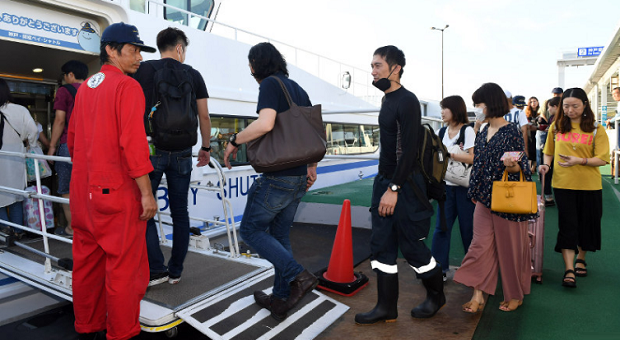Over 5,000 People Stranded At Kansai Airport

September 5, 2018 – Over 5,000 people stranded at Kansai International Airport on a man made island in Osaka Prefecture, which was flooded by a typhoon-triggered storm surge, began to move out of the airport by speedboat and bus today.
Typhoon Jebi, this season’s 21st, left at least nine people dead in Osaka, Shiga and Mie prefectures, according to a tally by the Mainichi Shimbun. The typhoon that had made landfall in the Shikoku and Kinki regions yesterday was downgraded to an extra-tropical cyclone by 9 a.m. this morning.
A storm surge caused by the typhoon flooded one of the two runways at the airport, as well as ramps and the basement of Terminal 1. Some towing vehicles and other means of transport were damaged by the flood.
Moreover, a tanker that was pushed by strong winds rammed into the bridge connecting the airport with the mainland, badly damaging part of the bridge’s piers, according to the airport. Some 5,000 air travelers as well as employees were stranded. Work has been underway since the predawn hours of today to remove the tanker.
Those stranded at the airport were initially transported to Kobe by speedboat. Buses were subsequently used to transport them out of the airport after it was confirmed that some lanes on the bridge were not affected by the accident.
The bridge, which is used for railway and car transportation, remains closed. West Japan Railway Co. (JR West) and Nankai Electric Railway Corp. will suspend services on their respective lines connecting the airport with Osaka Prefecture’s mainland for the time being.
All flights to and from Kansai International Airport were canceled today. There are no prospects that the airport will be reopened in the near future.
Railway operations remained suspended on the Kyoto and Kobe lines from Kyoto and Himeji, the entire Osaka Higashi Line and the Hanwa Line in Hineno and Wakayama in the aftermath of the typhoon.
The number of trains has been substantially reduced on the Kosei, Osaka Loop and Nara lines, as well as the Tennoji-Hineno section of the Hanwa Line.
Trains on the Hankyu Railway’s Kyoto and Senri lines have been delayed because many passengers who usually use other lines are using these lines as alternative routes. Services on the Nankai Railway lines, excluding the Nanba-Koyashita section of the Koya Line, were suspended because it takes a long time to repair damaged facilities or remove trees and other objects blocking the tracks. However, services were resumed on some sections later in the day. Trains have been delayed on almost all of Kintetsu Railway Co.’s lines.
The typhoon caused power blackouts in extensive areas of the Kinki region surrounding Osaka. At one point, power supply was cut off to over 2.1 million households, and about 575,100 of them are still left without power, according to preliminary figures released by Kansai Electric Power Co.
It is feared to take a long time before power supply to all households in the region will be fully resumed because power distribution systems were damaged by the typhoon.
Many residents of areas affected by the typhoon are still taking shelter. As of 5:30 a.m. this morning, evacuation orders were still out for over 29,000 people in more than 12,000 households in Hyogo, Nara, Okayama and Kagawa prefectures, according to the Fire and Disaster Management Agency.
Advisories were still in place for approximately 1.2 million people in over 550,000 households in extensive areas of western and central Japan — Ishikawa, Yamanashi, Nagano, Gifu, Aichi, Kyoto, Osaka, Hyogo, Nara, Okayama and Kagawa prefectures, the agency said.
